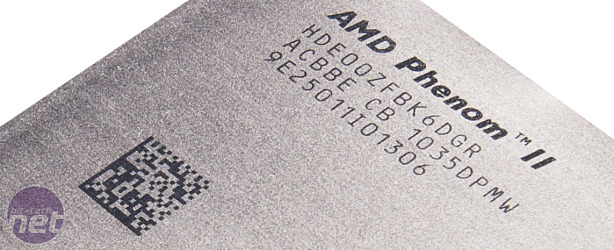
Performance
The 980 BE was disappointingly slow in our Media Benchmarks at its stock speed of 3.7GHz. Its score of 1,194 in our Gimp image editing test was a little faster than that of AMD’s 1100T BE, but way behind the i5-2500K, which managed a score of 1,594. Even more lamentable was the fact that the Core i3-2100 – a CPU that costs £50 less, has only two physical cores and is clocked 600MHz lower – scored 1,360.Unfortunately for AMD, this situation didn’t improve in the other tests, with the i3-2100 bettering the 980 BE by 67 points in the HandBrake H.264 video encoding test and by 124 points in the multi-tasking test. The 980 BE was also miles behind the i5-2500K, which was a colossal 878 points faster at video encoding and 351 points faster at multi-tasking.
Overall, the 980 BE scored 1,346, while the 1100T BE managed 1,442, the i3-2100 recorded 1,465 and the i5-2500K stretched to 1,889. The heavily multi-threaded Cinebench R11.5 and WPrime test results weren’t quite as disastrous for AMD, though, as the 980 BE scored 4.34 and 11.45 seconds here respectively. Comparatively, the i5-2500K managed a better score of 5.47 in Cinebench, and was 0.75 seconds faster in WPrime.
The 980 BE wasn’t particularly adept at games either, producing a minimum frame rate of 19fps in Crysis – 11fps slower than even the i3-2100 and a huge 15fps slower than the i5-2500K. Feeling lethargic after our disappointing benchmarking session, we headed into the test motherboard’s BIOS to try to improve matters. As 4GHz has proved an easy target for AMD CPUs such as the 1100T BE, we ramped up the vcore to 1.5V, and pushed the chipset and Southbridge voltages to 1.2V. Using a multiplier of 20x and an HTT of 200, we quickly arrived at our first milestone.
Click to enlarge
After some tinkering, we managed to reach the Windows desktop with the 980 BE running at 4.4GHz, using a vcore of 1.568V, although Prime95 failed after a few minutes. By then the CPU temperature had reached 80˚C, so we decided to find the next stable point; this was 4.3GHz, using a multiplier of 20 and an HTT of 215MHz. Unusually, this method of overclocking produced faster results than using an HTT of 331MHz and a CPU multiplier of 13x. This boosted the overall score in the Media Benchmarks to 1,563. In Crysis, the minimum frame rate rose from 19fps to 24fps but both results are still a long way from being a threat to the i5-2500K.
Conclusion
AMD’s last Phenom-branded CPU is a mixed blessing. In effect, it’s the last of a generation ofCPUs that enables us to look forward to AMD’s new offerings. However, it also reminds us that AMD is currently lagging far behind Intel, not only in the performance stakes, but also in terms of power efficiency and value for money.
The i5-2500K costs only £20 more than the Phenom II X4 980 BE, and it's much faster. The 980 BE lacks grunt in all our benchmarks – even Intel’s inexpensive dual-core Core i3-2100 proved faster in some tests before we overclocked the AMD CPU. We can’t deny that AMD has made some headway though: its latest CPUs are faster, more power-efficient and more overclockable than those of around a year or two ago.
This is good news if you own a compatible motherboard – while Intel’s offerings are superior, buying a new CPU will nearly always be significantly cheaper than forking out for both a CPU and motherboard. If you’re putting together a brand new system, though, Phenom’s last hurrah falls a long way short of convincing us to opt for anything other than Sandy Bridge.
-
Speed30 / 50
-
Features13 / 15
-
Value20 / 35


MSI MPG Velox 100R Chassis Review
October 14 2021 | 15:04









Want to comment? Please log in.